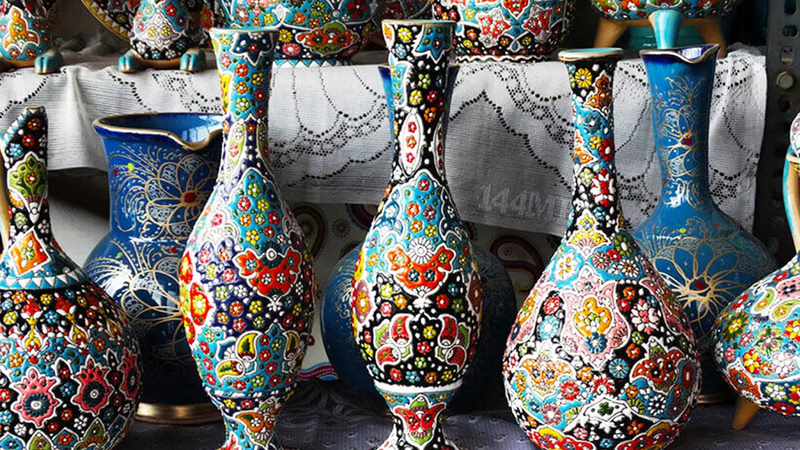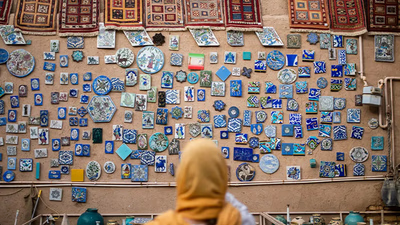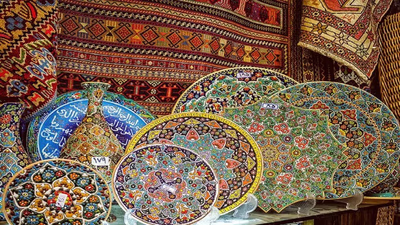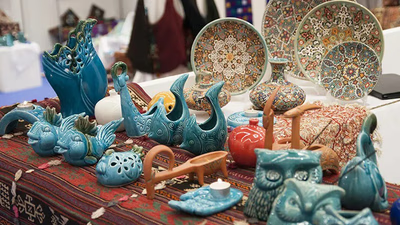
Handmade crafts showcase cultural heritage and artistic skills.
Handicrafts and traditional crafts are forms of artistic and skilled craftsmanship that involve the creation of objects or decorative items using traditional methods and techniques. These crafts often have a long history and are deeply rooted in the culture and heritage of a particular region or community. Handicrafts and traditional crafts are typically made by hand, using simple tools and materials, and they often reflect the local traditions, aesthetics, and materials available in a specific area.
Handicrafts refers to works, industries and arts, the whole process of making of which is done using hands and manual tools. Stages derived from the culture, art, vision and taste of the people of each region, which is accompanied by the seasoning of the creativity of the artisans of these industries, and makes the role of these works of art different from the similar works of machines and directly on the soul and heart.
Handicraft work is considered a job, and there are people all over the world who do extensive activities in this field and have been working in the field of handicrafts for a long time. This collection of work is made of decorative and functional necessities and other simple and complex tools. Features that should be considered for handicraft registration:
- Existence of cultural burden
- Not needing large investment
- Creating development in disadvantaged areas such as villages and nomadic communities
- High added value compared to other industries
- Reliance on domestic raw materials for construction
- Helping handicrafts to the growth of economy and industry in different fields
People of many countries of the world are famous for their textile industry and attractive designs. If you pay more attention to the designs of handwoven textiles, you will notice that in all of them traces of the culture and customs of the people of that country can be seen, and they often have an indication of the nature and geographical location of the people. Fortunately, with the progress of societies and technology, handicrafts and beautiful designs and colors of textiles have not disappeared and you can still enjoy watching them.
- Pottery and Ceramics
The art of creating objects from clay, shaping them by hand or using a potter's wheel, and firing them in a kiln to achieve a durable and often decorative finish. - Weaving and Textiles
The process of interlacing threads or yarns to create fabrics, rugs, baskets, and other woven products. This can involve techniques such as handloom weaving, tapestry weaving, and basket weaving. - Woodwork and Carving
The skill of working with wood to create functional or decorative objects, such as furniture, sculptures, masks, and intricate designs carved into wooden surfaces. - Metalwork
The manipulation of various metals, including iron, bronze, copper, silver, and gold, to produce jewelry, utensils, ornaments, and intricate metal designs. - Embroidery and Needlework
The art of decorating fabric or other materials using a needle and thread or yarn. This can include techniques like cross-stitching, embroidery, quilting, and appliqué. - Leatherwork
The craft of working with leather to create items like shoes, bags, belts, wallets, and decorative pieces through techniques such as cutting, stitching, and tooling. - Paper Crafts:
The creation of decorative and functional objects using paper, such as origami, paper cutting, paper quilling, and papier-mâché. - Glassblowing
The technique of shaping molten glass by blowing air through a blowpipe to create glass objects, including vases, bowls, and ornaments. - Basketry
The art of weaving natural materials, such as reeds, grasses, or vines, to create baskets, mats, hats, and other woven items. - Pottery Painting and Decoration
The application of various techniques, such as glazing, painting, and intricate designs, to decorate pottery and ceramic objects.
These crafts are often passed down through generations, preserving cultural traditions and techniques. They can also serve as a source of income for artisans and contribute to the local economy and tourism industry. Handicrafts and traditional crafts are valued for their uniqueness, craftsmanship, and the connection they provide to cultural heritage.
The Arts and Crafts movement emerged as a 19th century design reform and social movement mainly in Europe, North America and Australia and continues today. Its proponents were inspired by the ideals of movement founders such as William Morris and John Ruskin, who proposed that people in pre-industrial societies, such as the European Middle Ages, came together through the creative process of crafts.
-

West Asia is a significant hub for handicrafts, blending art and culture across 14 countries. This industry not only preserves cultural heritage but also generates income, with June 10th recognized as World Handicrafts Day. The region boasts renowned products such as Persian carpets, Turkish ceramics, Palestinian embroidery, and Yemeni jewelry, showcasing intricate craftsmanship and vibrant designs. However, despite its rich artistic legacy, the handicraft sector faces challenges, including economic instability and competition in international markets. Many artisans struggle to maintain their livelihoods due to ongoing conflicts in countries like Syria and Yemen. The potential for West Asia to become a major exporter of handicrafts is hindered by a lack of supportive policies and infrastructure. With over 295 registered handicraft fields and a community of 2 million involved in this sector, there is a pressing need for governments to implement protective measures and promote this valuable cultural industry. Addressing these issues could revitalize the handicraft market, enhance employment opportunities, and preserve the region"s artistic identity."
-

Handicrafts and traditional crafts represent skilled craftsmanship that creates decorative and functional items using traditional methods. These crafts are deeply rooted in the culture and heritage of specific regions, often reflecting local traditions and aesthetics. They are typically handmade, employing simple tools and materials, and are characterized by their cultural significance and economic potential. Handicrafts can include pottery, textiles, woodwork, metalwork, and more, each showcasing the unique artistry of the artisans. The production of handicrafts requires minimal investment and can foster development in disadvantaged areas, contributing to local economies. The crafts often carry high added value compared to other industries and rely on domestic raw materials. As societies evolve, the importance of preserving these traditional crafts remains, as they not only provide income for artisans but also enhance cultural tourism. The Arts and Crafts movement, which began in the 19th century, continues to inspire a renewed appreciation for handmade goods and the cultural narratives they embody.
-

Islamic art encompasses a diverse range of artistic expressions rooted in Islamic beliefs and principles across West Asia. This art form emerged following the advent of Islam, characterized by its prohibition of sculpting and portraiture. Instead, it emphasizes calligraphy, particularly Arabic calligraphy, which adorns various surfaces including mosques and manuscripts. Geometric patterns, known as arabesques, are prevalent in Islamic architecture, manifesting in intricate tilework and woodcarving. Notable styles include Persian miniature painting, Ottoman illumination, and Moroccan Zellige tilework. Techniques such as Ebru, which creates marbled designs on water, and traditional wood carving from Iraq further illustrate the richness of Islamic art. The historical context of Islamic art has attracted scholarly attention since the 19th century, leading to a deeper understanding of its significance and evolution. Regions like Iran and Palestine contribute unique crafts, including metalwork and Hebron tiles, showcasing the cultural diversity within Islamic art.
Sadu weaving from Saudi Arabia highlights the intricate craftsmanship of Bedouin communities, emphasizing the importance of textiles and patterns in this artistic heritage. Overall, Islamic art reflects a blend of spirituality, cultural identity, and artistic innovation, making it a vital aspect of the region"s heritage and trade."
-

Traditional industries and handicrafts are vital to the economies of Asian countries, providing employment and enhancing living standards. The global market for these products has expanded significantly, especially since the 1990s, leading to improved marketing strategies in wealthier nations. Notable art forms include Chinese calligraphy, Japanese origami, and Indian textiles, each showcasing unique cultural heritage. Countries like Korea and Thailand are recognized for their distinct pottery and silk weaving techniques, respectively. Indonesia"s batik and Tibetan thangkas further illustrate the diversity of Asian crafts. Vietnamese lacquerware and Persian miniature painting highlight the intricate artistry found throughout the region. Central Asia boasts a rich tradition of handicrafts, with local workshops offering immersive experiences for tourists. Despite extensive research, the origins of these art forms remain somewhat ambiguous, with many historians suggesting that they first emerged in India before spreading across Asia. The blend of tradition and modernity in these crafts continues to attract global interest, making them an essential component of the region"s trade landscape.




